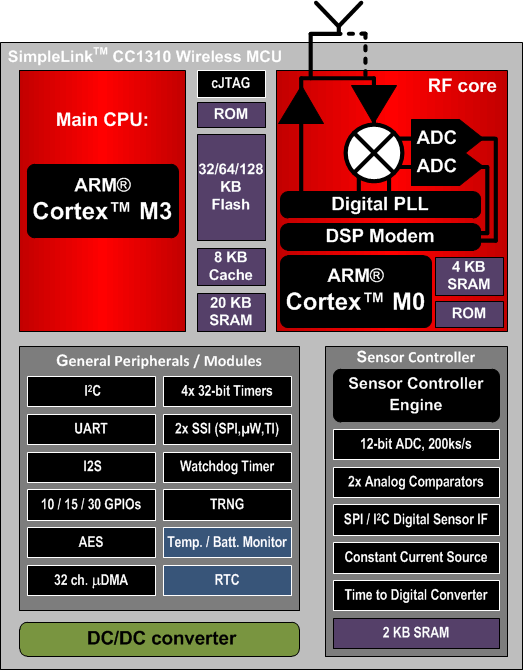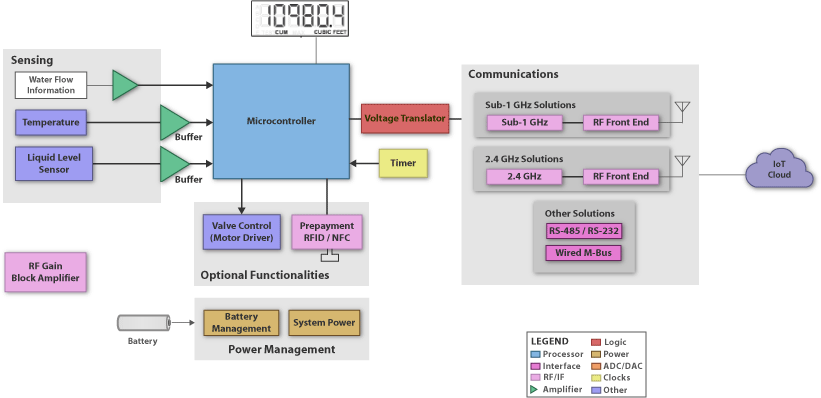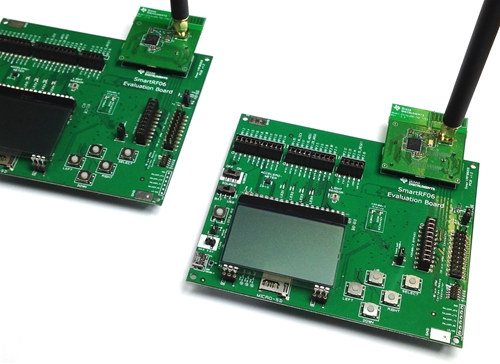Some LPWAN standards such as SigFox, LoRa, or nWave allows for transmission of data at low bitrate over several kilometers, and I’ve very recently featured Microchip’s LoRa modules and motes in this blog. So when Texas Instruments sent their December 2015 newsletter entitled Wireless MCU spans 20 km on a coin cell, I decided to have a look, and the company’s CC1310 wireless Cortex-M3+M0 MCU based on a proprietary sub GHz technology also claims to last 20-year on a coin cell for applications such as grid communication infrastructure and heat and water meters.

SimpleLink CC1310 key features:
- Microcontroller – ARM Cortex-M3 @ up to 48 MHz with up to 128KB programmable flash, 8KB DRAM for cache/general purpose, 20KB Ultralow Leakage SRAM
- Sensor Controller – Ultralow power and autonomous; 16-Bit Architecture; 2KB of Ultralow Leakage SRAM for code and data
- RF core
- Cortex M0 core with 4KB RAM, and ROM
- Data rate – 4000 kbps (Max)
- Receiver Sensitivity – –124 dBm using long-range Mode, –110 dBm at 50 kbps
- Selectivity: 52 dB; Blocking performance: 90 dB; programmable output power up to +14 dBm
- Single-ended or differential RF Interface
- Suitable for systems targeting compliance with ETSI EN 300 220, EN 303 131, EN 303 204 (Europe); FCC CFR47 Part 15 (US); ARIB STD-T108 (Japan)
- Wireless M-Bus and IEEE 802.15.4g PHY
- Peripherals
- All digital peripheral pins can be routed to any GPIO
- 4x general-purpose timer modules – 8x 16-Bit or 4x 32-Bit Timers, PWM each
- 12-Bit ADC, 200 ksamples/s, 8-Channel Analog MUX
- Continuous Time Comparator
- Ultralow Power Clocked Comparator
- Programmable Current Source
- UART, 2× SSI (SPI, MICROWIRE, TI), I2C
- I2S
- Real-Time Clock (RTC)
- AES-128 security module, True Random Number Generator (TRNG)
- Support for eight capacitive sensing buttons
- Integrated Temperature Sensor
- External System
- On-Chip Internal DC-DC Converter
- Few External Components
- Integration with SimpleLink CC1190 range extender
- Power Supply – 1.8 to 3.8V
- Power Consumption
- Active mode – Rx: 5.5 mA; Tx (+10 dBm): 12.9 mA; MCU: 48.5 CoreMark/mA; Sensor Controller @ 24 MHz: 0.4 mA + 8.2 µA/MHz
- Sensor Controller woken up once per second performing one 12-Bit ADC sampling: 0.85 µA
- Standby: 0.6 µA (RTC running and RAM and CPU retention)
- Shutdown: 185 nA (Wakeup on external events)
- Packages – 7-mm × 7-mm RGZ VQFN48 (30 GPIOs); 5-mm × 5-mm RHB VQFN48 (15 GPIOs); 4-mm × 4-mm RSM VQFN48 (10 GPIOs)

Software and development tools include reference designs for Different RF configurations, packet sniffer PC Software, Sensor Controller Studio, SmartRF Studio, SmartRF Flash Programmer 2, IAR Embedded Workbench for ARM, Code Composer Studio as well as development kits such as SimpleLink sub-1 GHz CC1310 development kit bundle comprised of one CC1310EMK-7XD-7793 evaluation module kit with two boards with the wireless MCU and RF layout (779 to 930 MHz) with two antennas, and two SMARTRF06EBK evaluation board that is the motherboard for the CC1310 evaluation module, and equipped with an on-board XDS100v3 debugger, LCD, buttons, LEDs, debugger and sensors.

TI CC1310 MCU is selling for $2.50 to $3.98 per unit for 1K orders, and the development kit is available for $299 + shipping. More details can be found on Texas Instruments SimpleLink CC1310 and CC1310 development kit product pages.

Jean-Luc started CNX Software in 2010 as a part-time endeavor, before quitting his job as a software engineering manager, and starting to write daily news, and reviews full time later in 2011.
Support CNX Software! Donate via cryptocurrencies, become a Patron on Patreon, or purchase goods on Amazon or Aliexpress






I found the original press release: http://newscenter.ti.com/2015-11-18-The-most-distance-with-less-power-TIs-new-Sub-1-GHz-solution-spans-20-km-on-a-coin-cell
It also supports TI-RTOS and Contiki 6LoPWan, and there’s a cheaper $99 evaluation kit @ http://www.ti.com/tool/cc1310emk?DCMP=cc1310launch&HQS=epd-wcs-lprf-cc1310launch-pr-tf-cc1310emk-wwe
OK but can these 2 connect easily to one another or do you need a special gateway to connect to ?
Also the evaluation kit is really expensive and I really hate proprietary stuff, it seems like there’s tons of them for low power long range. Would be nice to get a standard one.
@Marius Cirsta
The kit is said to include a “step-by-step software guide linking to point-to-point communication examples with TI RTOS”, so point to point should work.
Ah yes, just what we need, another proprietary, expensive “standard” that almost no-one will use…
I really wish technology companies could agree on a few universal standards, along the lines of Wi-Fi and Bluetooth and then negotiate with governments around the world to get a frequency band that could be used globally.
Anything sub GHz today uses at least a dozen different frequency bands if you’re looking at “900MHz” and it’s simply not practical from a manufacturing point, a stock keeping point and sales point. This is why Z-Wave is a pain and this will be no different, as you’ll need different antennas at the least to cover the full spectrum, or you’ll end up getting inferior antenna performance somewhere along the line…
@TLS
I fully agree but this usually is what happens when the tech is still young. At one point there will be a standard for this I hope but for now everyone has their own, it’s almost always like that in the start.
how did they test this? for ~900Mhz how could it travel that far without a high-tower(or from a satellite) + amplifier + open-air-LOS(line of sight)? I’m suspicious to say the least, a cell-battery + 900Mzh for 48Km is against physics I think.
http://www.qsl.net/pa2ohh/jsffield.htm
With 0dBi antennas gives a path loss of -125.2dBm at 900MHz
TX power +14dBm so you should be about 13dBm above the quoted RX sensitivity of -124dBm. So, 48Km LOS should provide a workable RX signal.
@TLS
They aren’t pushing any specific standard.